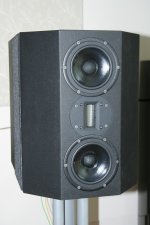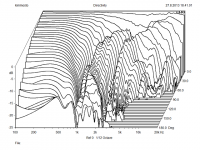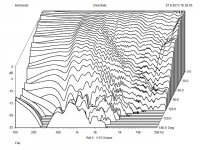I am in the process of building an active 4 way.
Below and above what frequencies does the human ear become less sensitive to lobing?
In a 4 way, it is very difficult to mate the upper mid driver and the tweeter.
If lobing is unavoidable, then perhaps making it symmetrical (MTM) is preferable.
Alternatively, can we move the MT crossover point higher and use a narrow dispersion tweeter instead. This would make the lobing worse, but is there a critical frequency beyond which lobing is not audible any more.
Same Q for the bass -midbass crossover point.
Below and above what frequencies does the human ear become less sensitive to lobing?
In a 4 way, it is very difficult to mate the upper mid driver and the tweeter.
If lobing is unavoidable, then perhaps making it symmetrical (MTM) is preferable.
Alternatively, can we move the MT crossover point higher and use a narrow dispersion tweeter instead. This would make the lobing worse, but is there a critical frequency beyond which lobing is not audible any more.
Same Q for the bass -midbass crossover point.
Lobing is not an issue if all drivers active at that frequency are spaced closer than 1/4 wavelength. Lobing becomes a challenge at higher frequencies.
100Hz = 136" --> 34" quarter wave
1000Hz = 13.6" --> 3.4" quarter wave
Many designs accept a modest lobe at the crossover frequency in order to use a looser 1/2 wavelength driver spacing. Home theaters, where a family sits together on a couch, have made wider 90 degree polar response controlled directivity waveguide tweeters a popular design.
Lobing and comb filtering from multiple lobes are a greater challenge in MTM than in TM, since both M-M spacing and T-M spacing must be considered. At every frequency, look at the surface area of all of the active drivers as a collection of vibrating points. Calculate the wavelength of that frequency. If there are multiple points at a distance equal or greater to this wavelength, then wave cancellation is possible from a pressure null between these points.
One of many good papers: "Vertically Symmetric Two-Way Loudspeaker Arrays Reconsidered"
Biro Technology
Simulate twice, cut once. If no other speaker in the world has the same driver alignment as yours, simulate 3 times before you cut.
Geddes Speak
Speak
VPR, Vertical Polar Response, at the FRD consortium
FRD Consortium
Xdir from
Tolvan Data
Sirp, The Edge, XDir (speaker analyzer, baffle diffraction sim and directivity sim
Products from Tolvan Data
Vertically Symmetric Two-Way Loudspeaker Arrays Reconsidered
Biro Technology
100Hz = 136" --> 34" quarter wave
1000Hz = 13.6" --> 3.4" quarter wave
Many designs accept a modest lobe at the crossover frequency in order to use a looser 1/2 wavelength driver spacing. Home theaters, where a family sits together on a couch, have made wider 90 degree polar response controlled directivity waveguide tweeters a popular design.
Lobing and comb filtering from multiple lobes are a greater challenge in MTM than in TM, since both M-M spacing and T-M spacing must be considered. At every frequency, look at the surface area of all of the active drivers as a collection of vibrating points. Calculate the wavelength of that frequency. If there are multiple points at a distance equal or greater to this wavelength, then wave cancellation is possible from a pressure null between these points.
One of many good papers: "Vertically Symmetric Two-Way Loudspeaker Arrays Reconsidered"
Biro Technology
Simulate twice, cut once. If no other speaker in the world has the same driver alignment as yours, simulate 3 times before you cut.
Geddes Speak
Speak
VPR, Vertical Polar Response, at the FRD consortium
FRD Consortium
Xdir from
Tolvan Data
Sirp, The Edge, XDir (speaker analyzer, baffle diffraction sim and directivity sim
Products from Tolvan Data
Vertically Symmetric Two-Way Loudspeaker Arrays Reconsidered
Biro Technology
I would think that the human ear is equally sensitive to lobing at any frequency that is in the audible frequency range. Vance Dickason (author of the Loudspeaker Design Cookbook) is not quite so stringent as 1/4 to 1/2 wavelength driver spacing. His guideline is driver spacing not more than 1 wavelength at the crossover frequency. Of course also a higher order of the crossover results in a less complex lobing pattern.
I would think that the human ear is equally sensitive to lobing at any frequency that is in the audible frequency range. Vance Dickason (author of the Loudspeaker Design Cookbook) is not quite so stringent as 1/4 to 1/2 wavelength driver spacing. His guideline is driver spacing not more than 1 wavelength at the crossover frequency. Of course also a higher order of the crossover results in a less complex lobing pattern.
Vance's vagueness is a problem. If we are talking using two 5" mids for example spacing can be ½ wavelength But if we are talking about MTM CtC spacing this must be at or less than ¼ wavelength. Lobing is not a problem if this is properly observed
Vance's vagueness is a problem. If we are talking using two 5" mids for example spacing can be ½ wavelength But if we are talking about MTM CtC spacing this must be at or less than ¼ wavelength. Lobing is not a problem if this is properly observed
Concerning what you say about driver spacing of the MTM, is this based on your own measuring or on the work of someone else? If based on something published, I'd be interested to know your source.
In a book by Ray Alden, Alden says that in the MTM arrangement, driver spacing should be kept close to one wavelength of the crossover frequency. His book was published in '95, so that might be dated, but he represents the one wavelength spacing as that prescribed by D'Appolito.
Just Curious.
cT
Well I have posted considerable amount of info here in other threads on the subject. Helped Juhazi sus out the issue with his Aino Gradient open baffle MTM section and have desiged MTM setups for over 25 years now.
This became critical in one speaker I built for personal use some 22 years ago now that was an MMTMMMWW.
This became critical in one speaker I built for personal use some 22 years ago now that was an MMTMMMWW.
If my understanding is not way off - the lobing issue becomes smaller the steeper the filter is.
1. order = large overlap and more prominent lobes
4. order = small(er) overlap and less prominent lobes
kris
1. order = large overlap and more prominent lobes
4. order = small(er) overlap and less prominent lobes
kris
Refrences to 1/2 wavelength and 1 wavelength CTC spacing in arrays can also be found searching for David Smith's (speaker Dave) paper, Jim Griffin's (jgriffin) Line array paper, JBL and countless others in addition to the previously mentioned authors. 😀
Thank you all for your comments.
However, the main question is still up in the air.
Let's put the MTM to one side and focus on a simple four way:
Driver spacing would not make much difference under 100Hz, because we are talking about wavelengths in excess of 3m anyway.
However spacing becomes very difficult in higher frequencies.
Esp if you are dealing with a 4 way and wish to cover no more than 2-3 octaves with each driver.
In that scenario, MT crossover ideally falls bang on the range of 5000-6000Hz.
The wavelength is around 6-7cm in that range.
One wavelength spacing is still doable, but the small drivers won't be very efficient.
So the theory is there, but can someone with experience tell us whether ctc higher than one wavelength at 5-6k crossover point makes any audible difference?
However, the main question is still up in the air.
Let's put the MTM to one side and focus on a simple four way:
Driver spacing would not make much difference under 100Hz, because we are talking about wavelengths in excess of 3m anyway.
However spacing becomes very difficult in higher frequencies.
Esp if you are dealing with a 4 way and wish to cover no more than 2-3 octaves with each driver.
In that scenario, MT crossover ideally falls bang on the range of 5000-6000Hz.
The wavelength is around 6-7cm in that range.
One wavelength spacing is still doable, but the small drivers won't be very efficient.
So the theory is there, but can someone with experience tell us whether ctc higher than one wavelength at 5-6k crossover point makes any audible difference?
5-6kHz is a big stretch for an MTM to work. Ray Kimber did an interesting test speaker at one show- had a bunch of little aura fullrangers acting as mids, in a circle around the tweeter.
I don't really remember the sound that well.
I don't really remember the sound that well.
My rational conclusion is that interdriver lobing can not be avoided in a multidriver speaker (unless we do a unity horn) There are some rules of thumb/guidelines about ctc distance and yes we have the simulators.
A clever way to avoid comb filter type problems in MTM is to use a coaxial mid-tweeter like KEF, TAD and even Genelec are doing now (not all mtm) Like zmyrna said, the real challenge is at the highest crossover. So, when that is a coaxial, we are on still waters! These are coming more and more popular. I do have 3
SEAS T18 coaxials as my home theater front speakers and I like them a lot! Here is a fine diy speaker with KEF coax by forum member gornir www.audioexcite.com Blog (but where has directivity gone betweeen 2-3,5kHz?)
Okay - what about intermodulation and doppler distortion and ragged on-axis response at highest frequencies with coaxials? Yes - we meet new different problems! Even KeF UniQ drivers have them.
A horn+compression driver is a popular choice with many virtues. But look at the various discussions about throat, exit and shape problems...
Your choice!
A clever way to avoid comb filter type problems in MTM is to use a coaxial mid-tweeter like KEF, TAD and even Genelec are doing now (not all mtm) Like zmyrna said, the real challenge is at the highest crossover. So, when that is a coaxial, we are on still waters! These are coming more and more popular. I do have 3
SEAS T18 coaxials as my home theater front speakers and I like them a lot! Here is a fine diy speaker with KEF coax by forum member gornir www.audioexcite.com Blog (but where has directivity gone betweeen 2-3,5kHz?)
Okay - what about intermodulation and doppler distortion and ragged on-axis response at highest frequencies with coaxials? Yes - we meet new different problems! Even KeF UniQ drivers have them.
A horn+compression driver is a popular choice with many virtues. But look at the various discussions about throat, exit and shape problems...
Your choice!
Last edited:
Lobing isn't necessarily a bad thing, not at all. It can reduce floor and celing bounce, in the nulls, depending upon details of the setup.
"Lobing is bad" - "lobing can help". It boils down to a simple and fundamental fact: we don't have a good understanding how our hearing works. If we would, it would be easy to define the optimal speaker characteristics. Currently we're all just discussing solutions to a problem we don't understand enough.
Any reasonable 4-way design should be able to have the first vertical nulls VERY far off axis and not much of any secondary lobes beyond that.
Why? What sizes are we talking about? edit: oh, I see it now, 5-6k and you want more efficiency than the small mids, and <3 octaves per driver. Well, there is probably a mid out there somewhere with efficiency since you're only talking down to 1k or so, but what about just moving ALL your xover frequencies down? 2.5-3kHz upper xover still meets your requirements.In a 4 way, it is very difficult to mate the upper mid driver and the tweeter.
Last edited:
Small flange domes have gotten cone 'n dome MTM design much more viable- it's gotten a lot easier to do a MTM with 7"s or so without having to cross over exceedingly low.
Here is an excellent example of a mtm construction with measurements, from kimmosto in a Finnish forum. Tee itse kuulumiset - Sivu 495
Mids SEAS MCA15, Tweeter Fountek NeoCD3.0 mid CtC=240mm
--> m-m vertical lobing starts at 3440/24/2=717Hz
Vertical lobing is compensated for power response by broad horizontal dispersion at same area.
Mids SEAS MCA15, Tweeter Fountek NeoCD3.0 mid CtC=240mm
--> m-m vertical lobing starts at 3440/24/2=717Hz
Vertical lobing is compensated for power response by broad horizontal dispersion at same area.
Attachments
Okay;
Because it is always a matter of compromises,
I will lay it out as a choice of two options:
Let's say you have a mid and a tweeter in hand,
a. you cross them around 2500Hz and stay barely within 1 wavelength CTC (cons; the tweeter is slightly distressed and you have the CO bang in the middle of critical range)
b. you cross them around 5000Hz (tweeter is happy, CO out of critical range, but CTC is greater than 1 wavelength and dispersion is narrower at CO point)
And let's assume the CO is DSP active, LR4.
Which one would you pick?
Can forum members with active systems test this for us?
Because it is always a matter of compromises,
I will lay it out as a choice of two options:
Let's say you have a mid and a tweeter in hand,
a. you cross them around 2500Hz and stay barely within 1 wavelength CTC (cons; the tweeter is slightly distressed and you have the CO bang in the middle of critical range)
b. you cross them around 5000Hz (tweeter is happy, CO out of critical range, but CTC is greater than 1 wavelength and dispersion is narrower at CO point)
And let's assume the CO is DSP active, LR4.
Which one would you pick?
Can forum members with active systems test this for us?
zmyrna, it's always beneficial to cross as low as possible in mtm. But then a robust tweeter is needed and there should be no room for a waveguide. But often we must deviate from the ideal... 5kHz is too high xo for any configuration, theoretically concidering lobing. I guess that kimmosto's mtm is crossed around 3kHz LR4, he doesn't tell. By the way m's are in an aperiodic enclosure, for dispersion control.
MT confiburation has also strong lobing with high xo, usually stronger down than up.
Directivity measurements are difficult to perform well, like kimmosto did with 5¤ increments (I use 15¤ increments). Should be done in a hall or outdoors. Very time consuming even with a turntable. And making an overlay/sonogram then.
Stereophile.com has vertical measurements usually only up to 5¤ (which doesn't tell anything) of their latest tests, but this YGA Sonja (mtm) is measured up to 45¤ YG Acoustics Sonja 1.3 loudspeaker Measurements | Stereophile.com
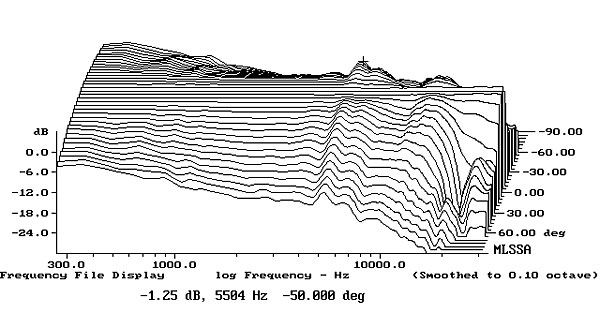
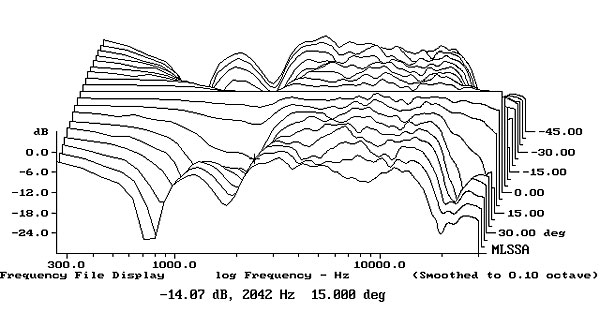
MT confiburation has also strong lobing with high xo, usually stronger down than up.
Directivity measurements are difficult to perform well, like kimmosto did with 5¤ increments (I use 15¤ increments). Should be done in a hall or outdoors. Very time consuming even with a turntable. And making an overlay/sonogram then.
Stereophile.com has vertical measurements usually only up to 5¤ (which doesn't tell anything) of their latest tests, but this YGA Sonja (mtm) is measured up to 45¤ YG Acoustics Sonja 1.3 loudspeaker Measurements | Stereophile.com


Last edited:
zmyrna, it's always beneficial to cross as low as possible in mtm. But then a robust tweeter is needed
Is there any tweeter that can go that low in order to maintain the 1/4 wavelength requirement?
- Home
- Loudspeakers
- Multi-Way
- Beyond what frequency range CTC distance becomes a non issue?
